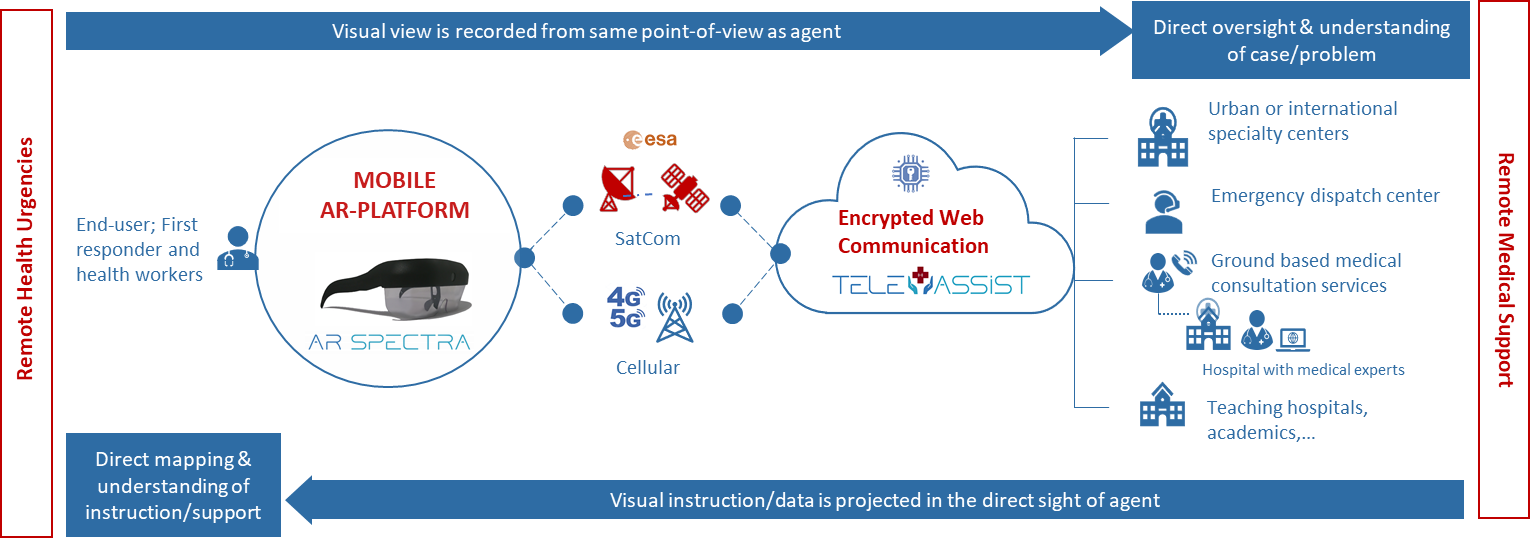
Objectives of the service
The TeleAssist project with ESA focusses on integrating the latest cellular and satellite-based communication technologies into mobile AR platforms in order to enable truly global remote assistance for medical care. From start on, the development is steered by the end-user requirements. Various operational trials and pilot studies allow to fine-tune the technology to the most effective and user-adapted AR-based assistance.
Users and their needs
Remote medical support agents, whether providing humanitarian care or outdoor emergency support, often require support from remote, more experienced medical experts. This verbal or in best case video- based communication is however often difficult to interpret by the remote expert and/or is obtrusive to the action of the mobile agent. A more natural interpretation of the medical case, and a hands-free visualization of the instructions can significantly improve the focus and success of both healthcare professionals.
A secure, reliable communication and access to medical expertise through bi-directional video-feedback has the potential to significantly increase the efficiency and success of mobile care leading to improved patient outcomes and reduced cost to unnecessary displacement to specialized medical centres.
Service/ system concept
The technology is a combination of the AR glasses and a tailored software platform integrating global connectivity management and data-encryption. As visual communication tool, it shares the same point- of-view observation as the agent, but especially allows remote instructions and support to be delivered in the direct sight of the local care giver. It offers the user real-time visual interaction and support of remote medical experts, regardless of geographical location.

The overall system consists of:
- A fully see-through head-mounted display with hands-free user control.
- A mobile processing unit with long term autonomy. Additional medical and diagnostic tools can be connected.
- A visual communication platform enabling AR-based remote assistance between a TeleAssist device and remote PC or server.
- Cellular & satellite-based connectivity and capacity management.
In general, the TeleAssist platform brings the most advanced video communication to the next level by two main advantages:
- The medical situation is recorded from the same point of view as the user, and transmitted in real time to a remote support agent. A “I see what you see” overview is created enabling the remote expert to be virtually focused on the case rather than to lose time and concentration to mentally comprehend the situation.
- The user in action receives the feedback, instructions, and medical data in his or her direct sight on the situation. Instead of verbal explanation, or by comparing with external displays, the information or action to be done is projected naturally in the direct view of the user.

This technology enables a dynamic two-way collaboration allowing remote visual validation, communication, expert diagnosis, and senior interdisciplinary assistance in medical treatments. These advantages are delivered on high-performance technologies with market-leading display quality, global and secure connectivity, designed to perfectly fit to the specific user actions and requirements.
The overall product end-results of this project and the benefits, provided by the TeleAssist, are higher treatment success, better patient outcomes, improvement of productivity or training. Reduction of care cost and displacement needs as well as improved care management are the primary economic drivers.
Space Added Value
More than one billion people worldwide cannot obtain the health services they need because those services are either inaccessible, unavailable, unaffordable, or of poor quality. Supporting different users and partners with limited access to the classic terrestrial and cellular networks, TeleAssist’s integrated SatCom communication delivers truly global, ubiquitous access to the relevant health care expertise.
Current Status
The TeleAssist project started with a review of the user and service requirements in collaboration with relevant partners, along with a technical and economic feasibility study. It assures efficient development feedback in order to deliver an optimal, final product fit. Several leading use-cases, sites and environments are evaluated and selected for prototype demonstrations.
For 12 months the technology is to be tested in the effective remote sites and assistance scenarios. These pilot trials allow to gather the necessary user and regulatory feedback necessary to fine-tune the technology to the final product. Continuous end-user feedback and evaluation guide the implementation of the commercialization plan and eventual roll out of for the technology and service.


